
Hemaris thysbe, the hummingbird clearwing, is a moth of the family Sphingidae (hawkmoths). Coloration varies between individuals, but typically the moth is olive green and burgundy on its back, and white or yellow and burgundy on the underside. Its wings are transparent with a reddish-brown border. It has light-colored legs, which combined with the lack of striping on the underside is diagnostic. Beating its wings rapidly, H. thysbe hovers to collect nectar from a variety of flowers. The combination of its appearance and its behavior commonly leads to it being confused with a hummingbird or bumblebee.
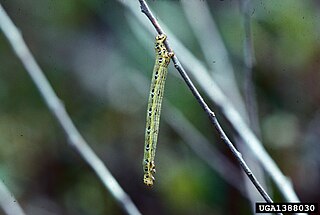
Cingilia is a monotypic moth genus in the family Geometridae erected by Francis Walker in 1862. Its only species, Cingilia catenaria, the chain-dotted geometer, chain dot geometer, chainspotted geometer or chain-spotted geometer, was first described by Dru Drury in 1773. It is found in North America from Nova Scotia south to Maryland and west to Kansas and Alberta.
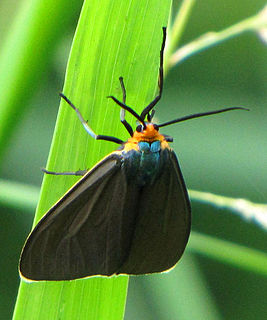
Ctenucha virginica, the Virginia ctenucha, is a moth of the family Erebidae. The species was first described by Eugenius Johann Christoph Esper in 1794.
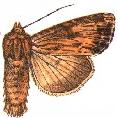
Apamea lignicolora, the wood-coloured Quaker or wood-coloured apamea, is a moth of the family Noctuidae. The species was first described by Achille Guenée in 1852. It is native to North America, where it is distributed across much of Canada and the United States.

Autographa ampla, the large looper moth, raspberry looper, brown-patched looper or broken-banded Y, is a moth of the family Noctuidae. The species was first described by Francis Walker in 1858. It is found in North America from Newfoundland west to the Alaska panhandle, south to central California, Arizona and New Mexico in the west and North Carolina in the east.
Hypena edictalis, the large bomolocha, is a moth of the family Erebidae. The species was first described by Francis Walker in 1859. It is found in North America from Quebec and Maine south to Virginia and Kentucky, west to the foothills of Alberta and the Peace River area of British Columbia.
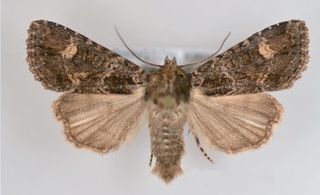
Aseptis binotata, the rusty shoulder knot moth, is a moth of the family Noctuidae. The species was first described by Francis Walker in 1865. It is found widespread in western North America, west of south-central Alberta, Wyoming, and Nebraska. Along the Pacific Coast it occurs from northern Mexico to south-central British Columbia. It can be found from sea level to altitudes over 2000 meters in a variety of habitats from dense forest to shrub desert.

Planotortrix excessana, the greenheaded leafroller, is a moth of the family Tortricidae. It is native to New Zealand and is an introduced species in Hawaii. It is extremely variable in appearance and feeds on many native and introduced species. It is regarded as a pest of some agricultural and forestry crops.
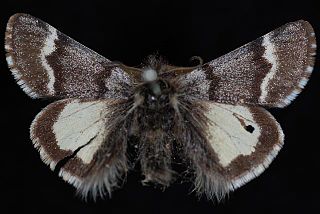
Leucobrephos brephoides, the scarce infant moth, is a moth of the family Geometridae. The species was first described by Francis Walker in 1857. It is found in North America from Yukon to Labrador and south to New York and southern Alberta and British Columbia. The habitat consists of open mixed wood forests of the boreal and mountain region.

Anavitrinella pampinaria, the common gray, is a moth of the family Geometridae. The species was first described by Achille Guenée in 1857. It is found in most of North America except the Arctic regions, south to Mexico.

Iridopsis ephyraria, the pale-winged gray, is a moth of the family Geometridae. The species was first described by Francis Walker in 1860. It is found in the United States and southern Canada east of the Rocky Mountains, from New Brunswick to Florida, west to Texas and north to Alberta.

Macaria aemulataria, the common angle moth, is a moth in the family Geometridae. The species was first described by Francis Walker in 1861. It is found from Nova Scotia to Florida, west to Texas, north to Oregon and Alberta.
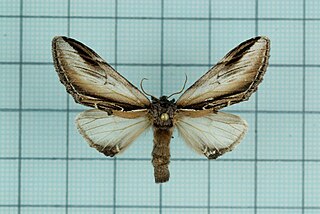
Pheosia rimosa, the black-rimmed prominent moth, fissured prominent or false-sphinx, is a moth of the family Notodontidae. The species was first described by Alpheus Spring Packard in 1864. It is found from coast to coast in North America, although it is less common in the south-eastern United States.
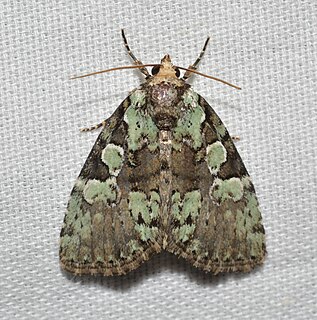
Leuconycta lepidula, the marbled-green leuconycta moth, marbled-green jaspidia or dark leuconycta, is a moth of the family Noctuidae. The species was first described by Augustus Radcliffe Grote in 1874. It is found in North America from Nova Scotia to North Carolina, west to Texas and north to Alberta.
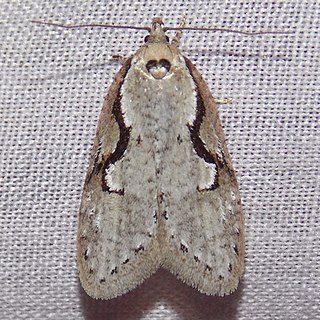
Semioscopis packardella, also called Packard's concealer moth or Packard's flatbody moth, is a species of moth of the family Depressariidae. It was described by James Brackenridge Clemens in 1863. It is found in North America in central Alberta, southern Quebec, Manitoba, California, Idaho and Oregon and from New Jersey to Ohio.

Hydrelia albifera, the fragile white carpet moth, is a moth in the family Geometridae. The species was first described by Francis Walker in 1866. It is found from Newfoundland to British Columbia, south in the east to the Gulf states. The habitat consists of deciduous and mixed-wood forests.

Choristoneura albaniana is a moth of the family Tortricidae. It was described by Francis Walker in 1863. In North America it is found from Alaska to Newfoundland, south through the mountains to California, Maine and New Hampshire. It is also found in the northern parts of the Palaearctic region, where it has been recorded from Sweden, Finland, Russia. The habitat consists of forests in boreal and mountainous regions.
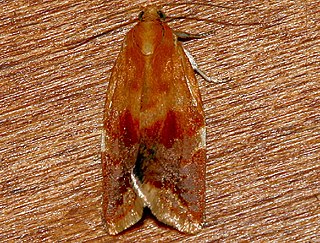
Clepsis persicana, the white triangle tortrix or the green needleworm, is a species of moth of the family Tortricidae. It is found in North America, where it has been recorded from Alaska and British Columbia to Newfoundland and south to Virginia and west to California. The habitat consists of coniferous and mixed coniferous forests.

Clepsis virescana, the light brown apple moth, is a species of moth of the family Tortricidae. It is found in North America, where it is widespread in southern Canada and most of the United States. The habitat consists of shrubby open areas and aspen parkland.
Chrysoesthia lingulacella, the silver-banded moth, is a moth of the family Gelechiidae. It was described by James Brackenridge Clemens in 1860. It is found in North America, where it has been recorded from Alberta, Arizona, California, Illinois, Indiana, Iowa, Maine, New Hampshire, Quebec and Texas.

















